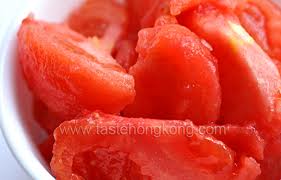“Does it really matter?” Brian asked me. I would say my husband was being sincere, and not lazy, but I know him. Definitely lazy.
“Get the tongs and get going.” I said. He obeyed. And, in the end, he agreed that it was better to follow the recipe. Imagine that: Joel Robuchon gives you a recipe and you discover that it’s wise to follow it! I am making slow progress with the man.
Tomorrow’s recipe, which is for Basque chicken, calls for skinned and seeded tomatoes.
Robuchon provides a wonderful tip on how to skin and to seed: you treat the tomato like a pepper and roast it.
Now, to begin with, does it really matter? Do you have to skin? Do you have to seed? No, you don’t have to. You don’t have to brush your teeth or ever take a shower or buy car insurance. But if you want to be civilized, if you want an exceptional recipe, then “skinned and seeded” means just that. The proof? Do a taste test.
Reluctance to skin a tomato is understandable. It’s awkward to get the skin off. Using a peeler is often a disaster where the poor tomato ends up both skinned and abused. That skin is very thin, yet remarkable strong. Oh, that strength? That’s what you would have to bite through and that’s why this exercise is necessary.
Now the standard technique for skinning or peeling a tomato is to place the raw tomato in a pot of boiling water for 10 seconds, then remove it and dunk it into a ice bath. It’s effective but just awkward with pots and pans and ice … There is negative incentive there to just say it’s too complex and skip the step. That’s a mistake.
If you compare tasting skinned and unskinned tomatoes, the difference is rather amazing. That thin skin is resistant to the bite. Not extreme, but enough to make a difference. A skinned slice is just simply sliced through, with no need to add that final touch of extra pressure to sever through the skin.
The same thing holds for seeds. Eat a slice of skinned and seeded tomato. Then try a skinned sliced with the seeds still there. There can be a perceptible difference there as your teeth engage the seeds and you automatically apply more pressure. I know, it’s slight. It’s a tomato. But it’s also real. Skinned and seeded, slices of tomatoes are sweet, meaty, and totally soft.
So, how do you do this? It’s better with a gas stove, but it’s still possible with electric. Turn a burner to high. If the burner is electric hold tomato in tongs over it and every 10 seconds rotate it. [Yes, with electric, that means putting the tomato down somewhere — not on the burner — and picking it up again with a different orientation.]
If the burner is gas, life is much simpler. The burner grate is 6 or 8 forks of metal that form a surface for pot or pan to sit on. Those forks all point to the center, but they typically they don’t meet there. They form a “hole.” Park the tomato in that hole, then every 10 seconds rotate it.
How do you know when you are done? The skin will begin to pucker or blister, turn yellow, and then blacken. When that effect is on most of the surface of the tomato, remove it from the burner and move on to the next tomato [or you can do multiple tomatoes on multiple burners]. Let the tomatoes rest for a few minutes, then simply remove the skin by hand.
Seeding is equally easy. Quarter the skinned tomato. With a small, sharp knife remove the “whitish” core with attached seeds. Using the edge of the knife, or your finger tips, brush the surface of the tomato to remove any remaining seeds.
This method is effective and avoids the clutter of boiling water and ice batch.
Source: The Complete Robuchon by Joel Robuchon

